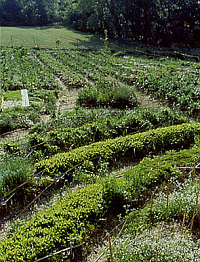
I have to admit, I’ve become a little obsessed by these beautiful beds, all curved and mounded in sweeping lines. I also love the very way they are constructed, in sort of gentle sweeping movements. Due to my terrain I’m not able to do them at my house, so I’ve been eyeing up other people’s gardens to work on.
Anyway, here are notes on the video including links to some other pieces on Emilia…
Emilia Hazelip – Synergistic Gardening
Based on work of Masanobu Fukuoka, The One Straw Revolution. 1978. Rodale.
Need to modify systems to our own location. Want to get high-yields whiile maintaining the soil’s own fertility.
No cultivation
No chemical or organic fertilisers
No chemical treatments
No compaction of the soil
Set out beds with sticks and then clear paths for your feet, mounding the soil into beds. Mounds should be 4 feet wide with 20 inches for the path. 10 – 30 inches for the beds deeper the beds the more room for the roots. Give them any shape you wish but make sure you can reach the centre of the beds easily.
Sheet mulch – cover the ground with cardboard. A good way to clear ground and you can grow potatoes at the same time.
Plants synthesise from light. Plants only take 2.5% of their mass from the soil. The rest comes from air and light. Plants give back much more to the soil then they take out.
Use marigolds all through the garden.
Beans and peas are legumes and fix nitrogen into the soil. You can use ash, which contains potash, to help grow your beans. This provides free fertiliser for your soil, the bacteria providing many benefits to your plants. These plants will also provide a living mulch between your plants. After harvest, the plants can simply be cut off, leaving the roots in the soil. the plant matter can simply be left on top of the beds. providing further mulch.
Synergistic gardening uses compost in the greenhouse or flats to start the plants – it doesn’t ‘force feed’ your soil with it.
Onions, garlic and leeks can be planted on the side of the garden beds. They function as pests controllers as well as being nutritious. They can be intermixed with other plants like lettuce or swiss chard.
Many plants reseed themselves – an advantage of letting plants finish their life cycle.
Mulching the mounds – Newspaper, cardboard, straw, leaves, wool. You can use grass clippings as mulch, but make sure you cut it and let it dry before it starts to seed. The first year the soill will be eating the mulch but as the organic contents in the soil improves, the amount of mulch needed will reduce. You will still need to weed, but it will gradually reduce – it’s all part of the evolving cycle.
Ducks (Indian Runner ducks), some birds, hedgehogs, lizards all eat slugs. Copper cuffs, or ones made from coke cans can protect plants from slugs.
When harvesting plants like lettuce, cut above the ground allowing the plant a chance to regrow, or providing dead matter for the soil to feed on.
Don’t stand on your beds! this will damage and compact the soil
Flowers are very important as they may attract beneficial insects, secrete chemicals to protect other plants (eg marigolds), or have edible, medicinal, or economic benefits as well as looking very attractive.
Diversity = a healthy, rich soil. Plants lots of plants with different root structures and leave those root structures in the soil when you harvest. Emilia says that force feeding your soil will create an imbalance or indigestion – let things work naturally – synergistically.
In nature, nothing happens in exactly the same way twice in the same spot. Diversify.
More information
The Synergistic Agriculture of Emilia Hazelip at the Fukoka Farming website

 I’m deciding on how to spend my garden budget this year. With the amount of seeds I’ve saved, contacts made and plants well established for propagating I’ve got a little more garden moolah to go around.
I’m deciding on how to spend my garden budget this year. With the amount of seeds I’ve saved, contacts made and plants well established for propagating I’ve got a little more garden moolah to go around.